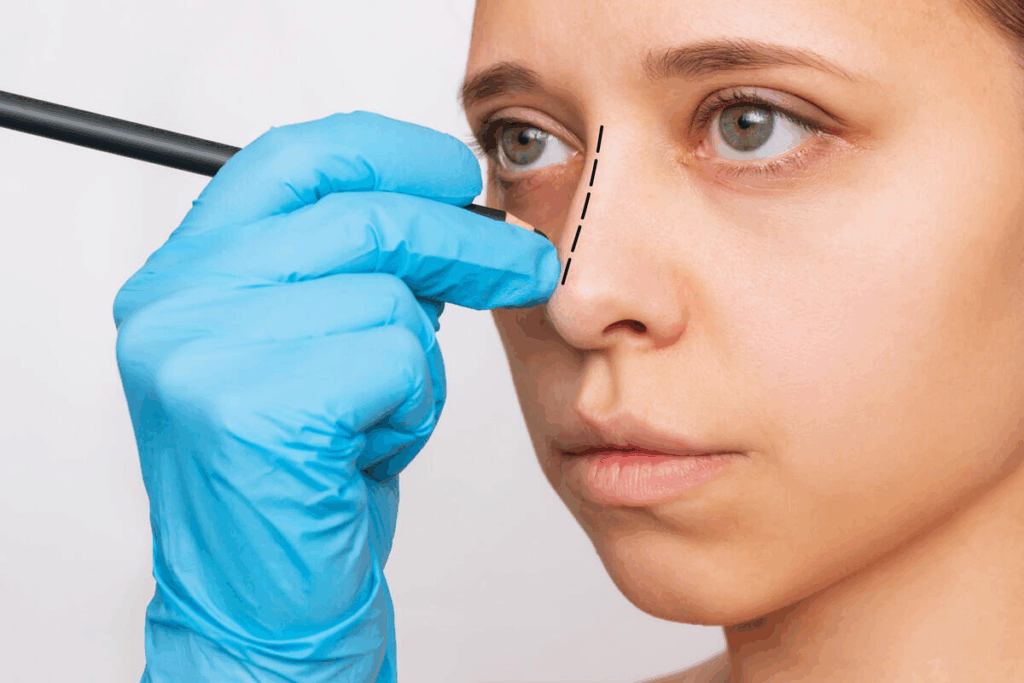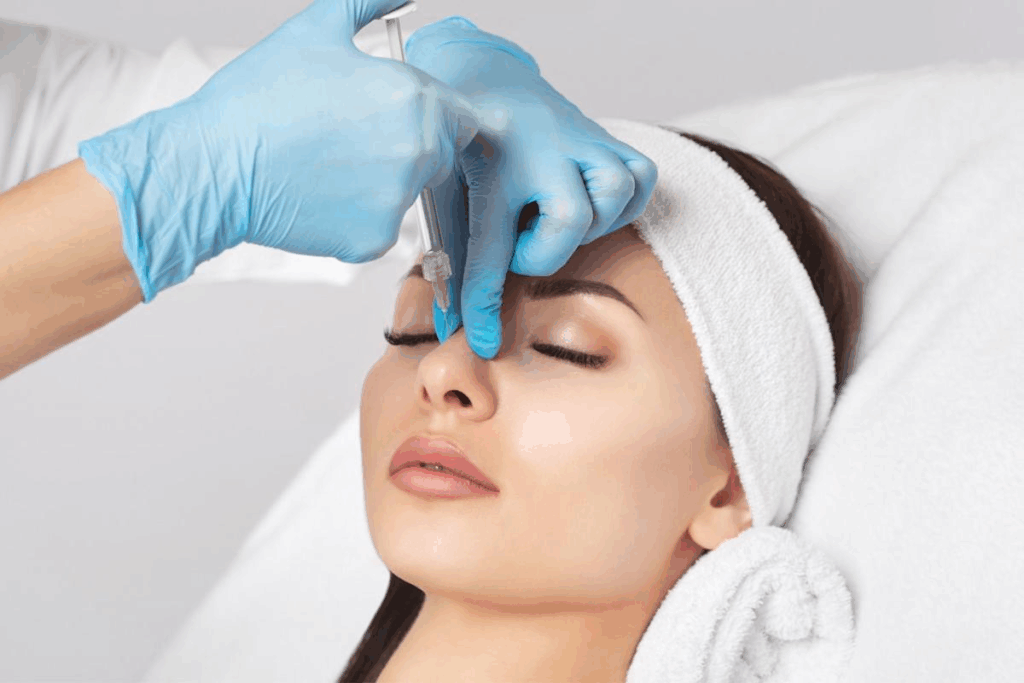
A deviated nasal septum is when the thin wall between the nostrils, called the nasal septum, gets bent or moved. This happens to more than 70 percent of people and can really affect how they breathe and sleep. Deviated septum treatment options, including medical relief for symptoms and surgical correction for structural issues.
At Liv Hospital, our team of experts uses the latest tools and proven surgical methods to fix nasal septum issues. It’s important to know how the nasal septum works and what symptoms mean. This helps us find the best way to treat it.

The nasal septum is a wall made of cartilage and bone. It’s key to the nose’s structure and can cause health problems if it’s off-center. It’s the wall inside the nose, made of cartilage in the front and bone in the back.
The septum is mostly cartilage in the front and bone in the back. This mix makes it strong and flexible. It’s covered in a thin membrane that keeps it moist and filters the air we breathe.
Septal deviation can happen for many reasons. Some people are born with it, while others get it from injuries. It can block airflow by moving the cartilage or bone, or both.
Getting hit in the nose is a common cause. This can happen in sports, accidents, or even at birth. Genetics can also play a part, making some people more likely to have a deviated septum.
Deviated septums can be S-shaped or C-shaped. An S-shaped septum bends in two opposite directions, like an ‘S’. A C-shaped septum bends in one direction, like a ‘C’.
Deviation Type | Description | Common Symptoms |
S-Shaped | Septum deviates in two opposite directions | Nasal obstruction, congestion |
C-Shaped | Septum curves in one direction | Nasal congestion, loss of smell |
Knowing the type and how severe the deviation is important for treatment. Experts, like deviated nasal septum specialists, help figure out and fix these issues.

A deviated septum can really mess with your daily life and sleep. It happens when the thin wall between your nasal passages gets out of place. This can make breathing harder and cause discomfort.
One big symptom is nasal obstruction or congestion. When the septum is off, air can’t flow right. This makes it hard to breathe and can make your nose feel stuffy.
Nasal obstruction is worse at night because it can make you breathe through your mouth. This can dry out your mouth and throat. It might even lead to rhinitis, a chronic nasal inflammation.
A deviated septum can also make your nose run a lot. The abnormal airflow can make too much mucus, leading to a runny nose. You might feel like you have excessive boogers all the time.
A deviated septum can also cause snoring, headaches, and sinusitis. The blocked airflow can make your throat vibrate, causing snoring. The pressure and congestion can also give you headaches.
Sinusitis, an inflammation or infection of the sinus passages, can happen too. It’s caused by the abnormal drainage from a deviated septum. This can lead to facial pain and pressure.
The symptoms of a deviated septum can really affect your daily life and sleep. Nasal congestion and breathing problems can make you tired. This can hurt your focus, productivity, and overall health.
The pain and discomfort from headaches and sinusitis can also lower your quality of life. It’s important to treat the deviated septum to get better.
Getting a deviated septum diagnosis involves several steps. It starts with checking yourself and then goes to professional tests. It’s key to know if your symptoms come from the septum or something else.
Before you see a doctor, you can check if you might have a deviated septum. Look for signs like always being congested, trouble breathing, and sinus infections. If you notice these, it’s time to see a doctor for a full check-up.
Doctors use a nasal speculum for a physical exam. They look inside your nose. Sometimes, they use nasal endoscopy for a closer look. They might also do CT scans to see how bad the deviation is and if there are other issues.
To get a diagnosis, see an Ear, Nose, and Throat (ENT) specialist. They know how to handle nasal and sinus problems. Make sure the doctor you choose has dealt with deviated septums before.
Knowing how to get diagnosed and finding the right doctor helps. This way, you can get the right treatment for your deviated septum.
Many people find relief from a deviated septum without surgery. It’s important to know about these options to make good health choices.
Managing deviated septum symptoms often starts with medication. Decongestants can lessen nasal congestion, making breathing easier. Antihistamines are good for those with allergy symptoms. Sometimes, nasal steroid sprays are used to reduce swelling.
Always talk to a doctor before starting any medication. They can choose the best treatment for you based on your septum and health.
There are also external devices to help with deviated septum symptoms. Nasal strips are a simple way to open up the nasal passages. A nasal dilator can also help keep the passages open.
Knowing about non-surgical treatments can help you manage your symptoms. Many people find relief without needing surgery.
Simple changes in your lifestyle and home remedies can help a lot with deviated septum symptoms. By adding these to your daily routine, you can feel better and live better.
Saline irrigation is great for cleaning your nasal passages and easing congestion from a deviated septum. Use a neti pot or a squeeze bottle with a nasal spray tip to clear out debris and mucus.
To make the saline solution, mix 1/4 teaspoon of salt and 1/2 teaspoon of baking soda in 8 ounces of warm water. Rinse your nasal passages once or twice a day, after being around allergens or pollutants.
Steam inhalation is another good home remedy for deviated septum relief. It loosens mucus, reduces congestion, and soothes your nasal tissues. Adding eucalyptus oil or menthol to the steam can make it even better.
To do steam inhalation, boil water in a big bowl. Then, lean over the bowl with a towel on your head to trap the steam. Breathe deeply through your nose for 5-10 minutes. Be careful not to burn yourself from the hot water.
Changing how you sleep can also help with deviated septum symptoms. Sleeping on your side can make congestion worse if the septum is more blocked on that side.
Try sleeping on your back with your head up using an extra pillow. This can help by letting mucus drain better.
Changing what you eat can also help with deviated septum symptoms. Eating foods that fight inflammation can reduce nasal swelling and improve sinus health.
Eating foods rich in omega-3 fatty acids, like salmon and walnuts, is good. Also, eating lots of fruits and vegetables, which are full of antioxidants, can help fight inflammation.
Food | Benefit |
Salmon | Rich in omega-3 fatty acids, reducing inflammation |
Walnuts | High in omega-3 fatty acids and antioxidants |
Fruits and Vegetables | Packed with antioxidants, fighting inflammation |
By using these home remedies, people with a deviated septum can feel a lot better. They can also improve their overall quality of life.
Surgery is often needed when other treatments don’t help. A deviated septum can cause a lot of problems, like breathing trouble and sleep issues. We’ll look at when surgery is needed, its benefits and risks, and what to expect.
Several signs suggest surgery might be the best choice. These include:
If these conditions are present, surgery could greatly improve your life.
For severely deviated septums, surgery is often the best option. This is true, even more so for S-shaped deviations. The surgery needed for these cases is more complex to fix the septum and improve breathing.
Deviated Septum Type | Surgical Complexity | Expected Outcome |
Mild Deviation | Low | Significant improvement in nasal breathing |
Moderate Deviation | Moderate | Improved nasal function and reduced sinusitis |
Severe S-Shaped Deviation | High | Correction of nasal obstruction and related symptoms |
Most deviated septums can be fixed with surgery. But, success depends on the severity and other health issues. An ear, nose, and throat (ENT) specialist must evaluate each case to find the best treatment.
Surgery for a deviated septum, like septoplasty, has many benefits. These include better breathing, fewer sinus infections, and a better quality of life. But, there are risks like bleeding and infection. It’s important to talk to your doctor about these to make a good choice.
Understanding when surgery is needed, the types of deviations it can fix, and its benefits and risks helps patients make informed decisions. Surgery is a good option for those with a bad deviated septum, aiming to improve symptoms and overall health.
A deviated septum can be treated with several surgeries. Each one is designed for the person’s specific needs. These surgeries help improve breathing, reduce blockages, and ease symptoms.
Septoplasty is the most common surgery for a deviated septum. It removes or moves the deviated parts of the septum. This makes it easier to breathe through the nose. The surgery is done under general or local anesthesia with sedation.
Benefits of Septoplasty:
Some patients need septoplasty and rhinoplasty together. This fixes the septum and improves the nose’s look. It’s great for those with both breathing and beauty issues.
“Combining septoplasty with rhinoplasty allows us to address both the functional and aesthetic aspects of nasal surgery, providing a more complete solution for our patients.” – Dr. John Smith, ENT Specialist
Endoscopic septoplasty is a new way to do septoplasty. It uses an endoscope to see the septum. This method is less invasive and can cause less pain and faster healing.
Turbinate reduction is often done with septoplasty. It makes the nose’s airflow better. The turbinate bones can grow big and block the nose. Making them smaller helps septoplasty work better.
Surgical Procedure | Purpose | Benefits |
Septoplasty | Correct deviated septum | Improved breathing, reduced congestion |
Rhinoplasty with Septoplasty | Correct deviated septum and nasal aesthetics | Functional and cosmetic improvement |
Endoscopic Septoplasty | Minimally invasive correction of deviated septum | Less discomfort, quicker recovery |
Turbinate Reduction | Reduce size of turbinate bones | Enhanced nasal airflow |
Knowing the different surgeries helps patients make better choices. Talking to an experienced ENT specialist is key to finding the right surgery.
Getting ready for deviated septum surgery is key to a good outcome. It helps avoid risks and makes recovery easier.
Pre-surgery talks are very important. Your surgeon will check how bad your septum is and plan the best surgery. Be honest about your health history, allergies, and meds. This helps your surgeon plan just for you.
Before surgery, you’ll have many tests. These check your health and nasal condition. These tests help plan your surgery.
Some meds can mess with your surgery or cause problems. Tell your surgeon about all meds, including blood thinners and herbal stuff. They might ask you to stop some before surgery.
Knowing what to expect from surgery is important. It can really help your breathing but might not fix everything. Talking to your surgeon about what you hope for can help you get ready for recovery.
By following these steps and working with your team, you can get ready for a successful surgery.
Recovering from septoplasty means knowing about immediate care, managing pain, and possible issues. Knowing what to expect can ease your mind and help your healing.
Right after surgery, you’ll stay in a recovery area for a few hours. We make sure you’re comfortable and safe before you go home. It’s important to have someone with you for the first night.
Key aspects of immediate post-operative care include:
Controlling pain is key to recovery. We give you pain meds to help. Saline nasal sprays also help keep your nose moist and aid healing.
Tips for managing pain and discomfort:
Healing times vary, but most people can get back to normal in one to two weeks. But, it can take months for all swelling to go down and for you to see the full results.
Timeframe | Healing Progress |
1-2 weeks | Return to normal activities |
2-4 weeks | Significant reduction in swelling |
Several months | Full recovery and final results |
Septoplasty is usually safe, but watch out for infections, bleeding, and holes in the septum. Keeping an eye on your symptoms and following up with your doctor can help avoid these issues.
By understanding the recovery and following care instructions, you can reduce risks and get the best results from your septoplasty.
Managing a deviated septum well needs a mix of medical care and lifestyle changes. Knowing the deviated septum treatment options helps people choose the best way to feel better.
We’ve looked at different ways to manage deviated septum symptoms. This includes non-surgical and surgical methods. Using these together can greatly improve life for those living with a deviated septum.
Getting the right diagnosis and treatment is key. With proper care and changes, people can live comfortably. They can enjoy better nasal function and overall health.
A deviated septum is when the thin wall between the nasal passages is off-center. This makes one side smaller than the other.
Signs include blocked nose, runny nose, and too much mucus. You might also snore, have headaches, or get sinusitis. These can really affect your daily life and sleep.
To find out, you can try to figure it out yourself. But a doctor will do a physical check and might use imaging tests. They’re experts like otolaryngologists or ENT doctors.
Yes, you can try non-surgical ways first. This includes medicines and devices to help symptoms. You can also try home remedies like saline rinses, steam, and changing your diet.
Surgery, like septoplasty, is needed for serious cases. It’s for when symptoms really bother you and affect your life a lot. Signs that surgery might be needed include a blocked nose, sinus infections, and a lot of nasal discharge.
Surgery can make breathing easier, reduce discharge, and lower sinus infection risk. But, there are risks like bleeding, infection, and changes in your nose’s shape.
Get ready by going to pre-surgery talks, doing tests, and adjusting your meds. Also, know what to expect to make recovery easier.
Recovery starts with post-op care, managing pain, and watching for problems. Healing times vary, but most people get back to normal in a few weeks.
Yes, it can lead to snoring, sleep apnea, and sinusitis. These can affect your health and life quality more broadly.
Living with it is possible, but untreated cases can cause ongoing symptoms. These can get worse over time, affecting your health and well-being.
Subscribe to our e-newsletter to stay informed about the latest innovations in the world of health and exclusive offers!
WhatsApp us